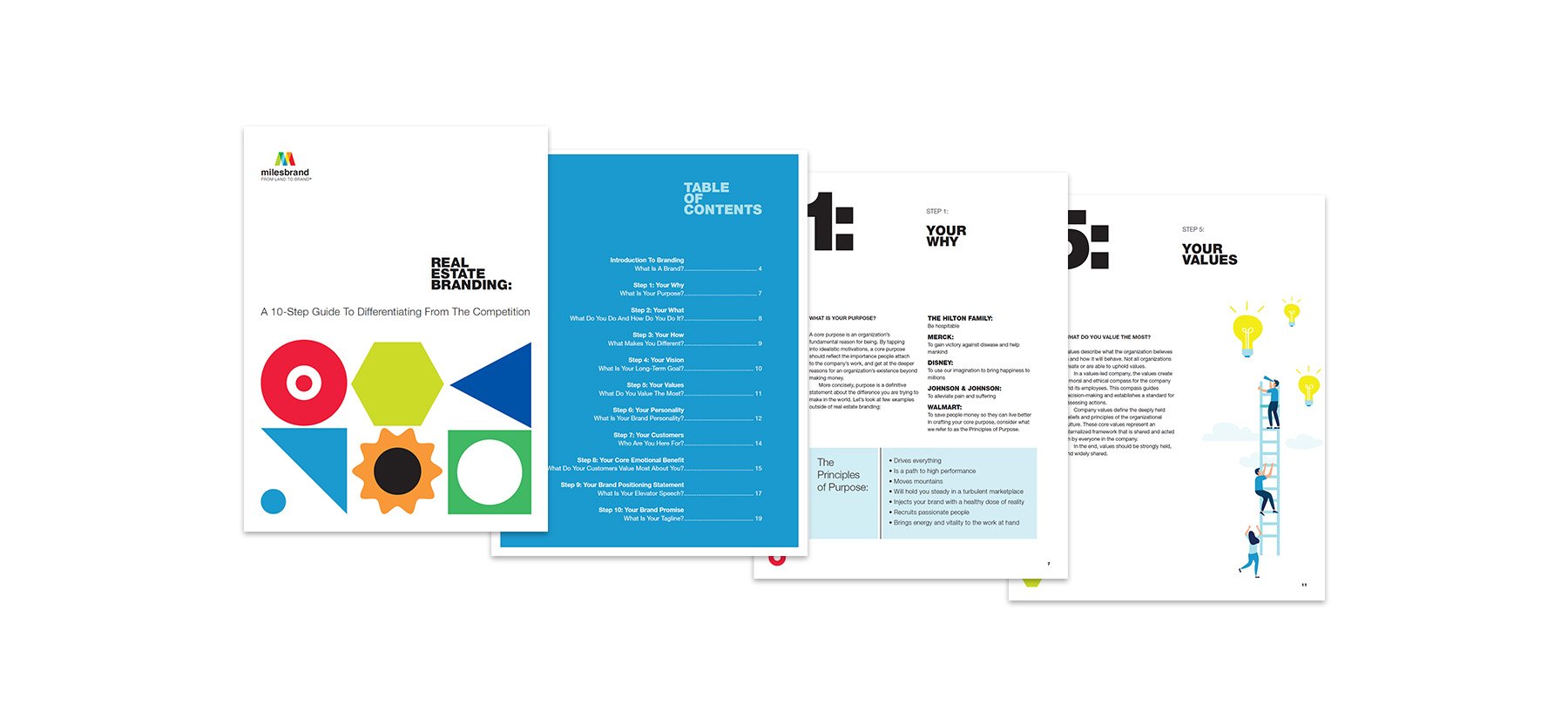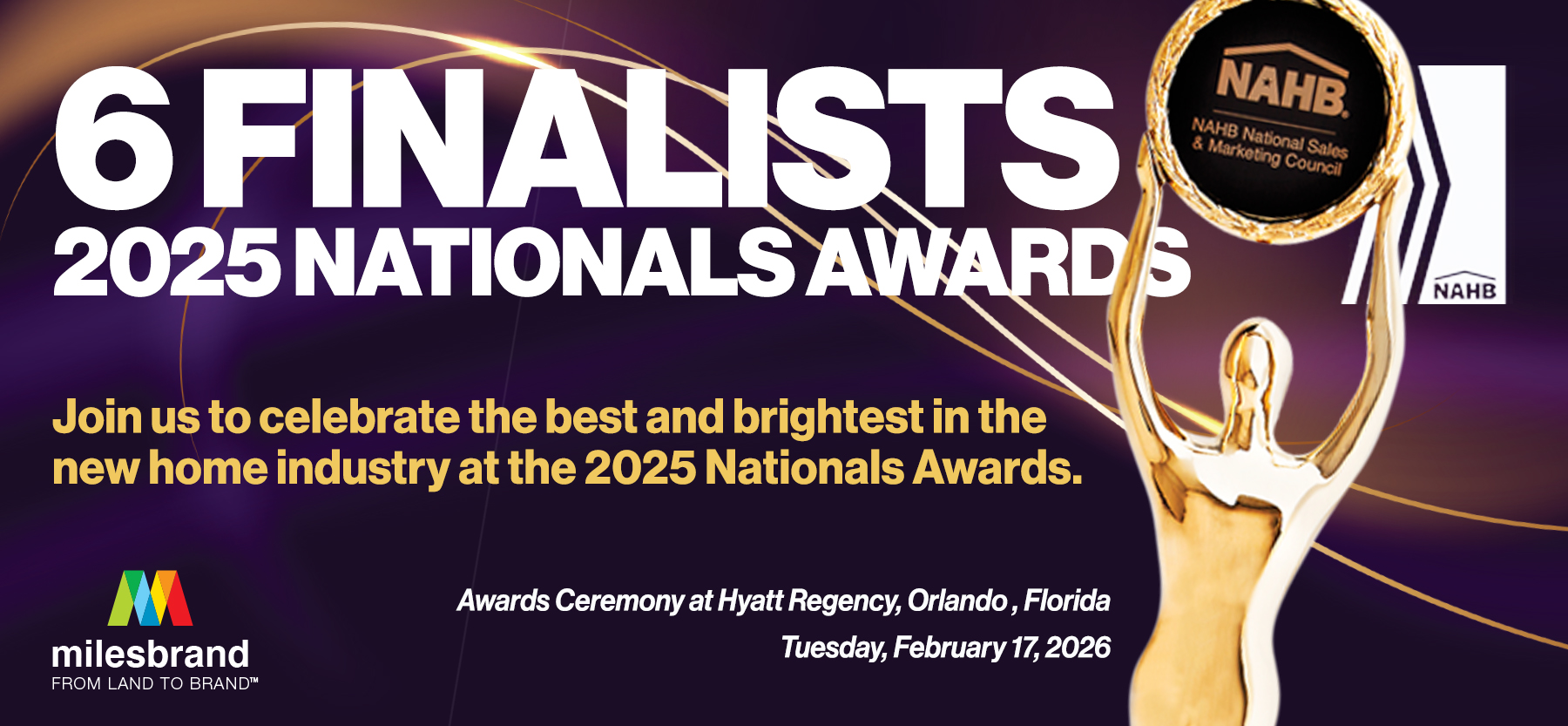January 13, 2022
Real Estate Branding: A 10-Step Guide to Differentiating
Every home builder, developer and anyone in real estate branding recognizes the need to differentiate from the competition. Developing a strong real estate brand is merely the first step to establishing a powerful branding strategy and achieving strong sales. There are many strong real estate brands, but it’s crucial to distinguish your company from competitors to gain interest from your target audience.
Successful real estate branding requires a deep understanding of the brand’s identity including values, purpose, goals, intended audience and what sets your company apart. Unfortunately, few have the training and skillset to accomplish such an important strategic initiative.
That’s because they have never been exposed to a definitive, step-by-step process that leads to the creation of a sustainable, competitive consumer advantage.
Today, we’ll be taking you through every possible side of a branding problem, while we work through our 10 step guide to real estate branding. If you’d like to jump to a specific section, click one of the links below.
DOWNLOAD A PDF OF THIS GUIDE:
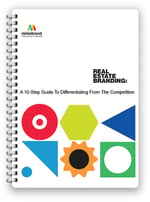
10 Steps for Real Estate Branding
- Your Why – What is your purpose?
- Your What – What do you do and how do you do it?
- Your How – What makes you different?
- Your Vision – What is your long-term goal?
- Your Values – What do you value the most?
- Your Personality – What is your brand personality?
- Your Customers – Who are you here for?
- Your Core Emotional Benefit – What do customers value most about you?
- Your Brand Positioning Statement – What is your elevator speech?
- Your Brand Promise – What is your tagline?
What is a brand?
Before we move into Step 1, it will be helpful to first answer a fundamental question: What is a brand?
In our view, a brand is an emotional bond that connects people with products and services. Brands are visual, emotional, rational and cultural images that people associate with a company.
In fewer words, a brand is your reputation.
It provides a way for your audience to learn and understand what the company stands for, what it aims to achieve and how it plans to do so.
Real estate branding is a way for home builders and developers to coherently express the business’ identity, vision and unique value given to its homebuyers. Ultimately, branding is the first step to building trust between a home builder or community and its collective audience. These are people shopping for a new home, current residents, their relatives, visitors, the surrounding local community, the press and anyone else who comes in contact with the brand. The more information these individuals are given about your brand, the better an opportunity your company has to earn their trust, gain greater awareness and reach fantastic sales.
Every action we take as individuals and professionals either increases or decreases this trust. Knowing branding is about building trust demands we become more intentional in our brand management practices. Strong branding is truly the key to creating relationships with audiences as it offers your company an opportunity to present an identity that resonates with homebuyers.
Trust is not built on chance or happenstance. Trust is earned by living up to the promises we make.
Less successful brands lack an understanding of their values and audience needs. As a result, they are unsure of what to promise. And because they are unable to identify their unique value to the target audience, they confuse the marketplace and become lost among the brands with a stronger voice.
Brands that do not have a clearly defined promise are forced to live in a world of reaction instead of leadership. Rather than characterizing their company and creating clear expectations for the audience, these brands are left with the challenge of attempting to meet all homebuyer demands. Consequently, brands without defined value are more likely to fall short.
On the other hand, leading brands understand trust is the key to ongoing success. They make Brand Promises that respond to what’s most important and relevant to the target markets they want to form relationships with. Then, the brand directs its energy towards fulfilling those promises.
How do you know if you have a brand?
Chances are, you do. Every community and every home builder has a brand – it’s all about uncovering it and sharing it with your target market in a compelling way.
Just as each person has their own distinct traits and quirks, so does each real estate brand. Whether they realize it or not, each company has unique perspectives, values, visions and assets. It’s important to think back to why the company was created and how it was intended to provide new value to homebuyers. The power of real estate branding is revealed in how conscious or unconscious developers and builders are about nurturing, growing and protecting their unique value proposition.
How will real estate branding help?
Branding makes things easier and more efficient. Exceptional real estate branding persuasively communicates the benefits of buying with your brand to homebuyers which leads to stronger sales performance. This is because a well-understood and consistently communicated brand simplifies the hard problems of real estate buying – choices, saving time and saving money.
Externally, by consistently communicating what the brand is, good branding reduces marketing costs and increases return on sales and marketing investments.
And internally, branding is equally important to sharing who the brand is and represents. It improves internal clarity and provides a stronger understanding of the culture your team aims to possess. By knowing the spirit the brand encompasses, you can hire individuals who embody the brand which improves teamwork and leads to higher job satisfaction and productivity.
To Create a Powerful Brand, Understand the Basic Truths
Truth #1: Defining and distilling the brand is the job of top management.
What the home builder or developer believes in, how they want to be perceived, how they choose to operate and what kind of reputation they aspire to can only be determined by top management and leadership.
Now more than ever, guiding the brand should be a top priority. It’s not a task that can be handed off to someone less busy or a committee. Defining and distilling a brand takes vision, insight, courage and commitment – qualities that strong leadership should always possess.
Because branding is so central to what the enterprise or community stands for, it’s entirely accurate to equate branding with business management. In fact, brand knowledge and commitment to the core values guiding it determine business strategy.
Branding is a testament to both the company’s current focus and where it’s headed in the future. This is something that can only be determined by the brand’s leaders – if they don’t know the answers to these important questions, this is crucial to address.
Understanding the significance of this essential business principle goes a long way toward explaining why so many companies struggle with focus and consistent, predictable practices. They simply don’t know what they stand for and have never taken the time to determine and communicate it.
Truth #2: Seek Unique – Branding takes place in the mind.
Branding is a collection of impressions. Each person that comes in contact with a brand constructs his or her own individual portrait based on their personal experience and understanding.
The way that people build their own idea of what a home builder or community is similar to how birds build nests – from scraps and straws they happen to discover. These scraps can be equated to the brand information available to your audience through Google searches, word-of-mouth, your social media posts, online reviews, etc. The impressions provided from these places aren’t always fair or rational and they’re often very fragmented. But it’s what makes effectively communicating the brand so important.
Each brand touch point available to your audience provides a different piece of the puzzle that illustrates a component of your brand identity. What’s crucial is deterring homebuyers from gaining a negative impression of your brand based on the content they find online by intentionally shaping all forms of brand expression. Although some things can’t always be avoided, such as negative reviews, it’s important to focus on what you can control to establish a meaningful brand that offers homebuyers positive associations.
This means, first, there must be some kind of distinction – something that sets the brand apart – so people can associate with it a unique identity that has meaning and value. This is called positioning the brand.
Once the brand positioning is determined, it must be communicated consistently – and predictably – at all possible touch points with all audiences.
Truth #3: Communicate Consistently – The key to achieving a high return on a branding investment.
Brands are built by communicating them 360 degrees – that means consistently and thoroughly. Starting internally, leadership must understand the importance of not only educating their employees about the brand but indoctrinating them.
People, after all, are an extension and important representation of the brand. So unless everyone is on the same page, there is bound to be confusion and frustration. A lack of internal brand knowledge translates into higher levels of external miscommunication and disappointment for everyone that interacts with the brand.
A brand can only create strong connections with its audience if it is cohesive and well-expressed. Consumers don’t trust brands that are inconsistent and misleading, but they do place faith in brands that provide a unified, recognizable identity. Not only does consistent branding inspire trust, but it also enhances brand awareness and recognition – critical factors for achieving a robust ROI.
Most people recognize the value of a consistent graphic identity. But effective real estate brand communication goes way beyond using the same colors on signage, collateral and advertising. Every point of contact communicates the brand – the way the phones are answered, the look and feel of the sales offices, the model homes, entry monuments, signage and the way people are treated.
Every interaction provides another clue about how intentional – how serious – the home builder or developer is about the customer experience they are trying to produce and the reputation that will follow.
Step 1: Your Why – What is your purpose?
“Where your talents and the needs of the world cross, there lies your calling.”
Aristotle
A core purpose is an organization’s fundamental reason for being. Why was the company created? What was the company meant to provide and why?
Every successful company is driven by more than profit. They’re motivated by the opportunity to enhance the universal human experience. By tapping into idealistic motivations, a core purpose should reflect the importance people attach to the company’s work and speak to the deeper reasons for an organization’s existence beyond making money.
More concisely, purpose is a definitive statement about the difference you are trying to make in the world.
Let’s look at a few examples outside of real estate branding:
- The Hilton Family: Be hospitable
- Merck: To gain victory against disease and help mankind
- Disney: To use our imagination to bring happiness to millions
- Johnson & Johnson: To alleviate pain and suffering
- Walmart: To save people money so they can live better
In crafting your core purpose, consider what we refer to as the Principles of Purpose.
The Principles of Purpose
Purpose…
- Drives everything
- Is a path to high performance
- Moves mountains
- Will hold you steady in a turbulent marketplace
- Injects your brand with a healthy dose of reality
- Recruits passionate people
- Brings energy and vitality to the work at hand
Step 2: Your What – What do you do and how do you do it?
At face value, this question doesn’t come across as the most taxing. You might be thinking, “We build homes in…”, or “We are a master-planned community in…” and that would be a great start. But there’s more to this answer than you’d initially assume.
The challenge here is to think deeply about the question and search for an answer infused with meaning and emotion, as opposed to simply what you do. Rather than expressing what the organization does in a straightforward way, try describing your work before there were specific homes and master-planned communities to speak of. Go beyond the hard facts of what your brand does and consider the emotional value of what the business was originally intended to provide.
Admittedly, that’s the hard part. But if great branding wasn’t on the other end of at least some insight, we’d see nothing but fantastic brands. And that doesn’t quite describe the reality we’re in. Successful branding necessitates a compelling vision that inspires and elevates the company’s specific functions.
For your “What”, the more descriptive and process-focused, the better. And remember, you can always revisit earlier steps as you continue to work through the rest.
Step 3: Your How – What makes you different?
Even if your brand’s purpose is meaningful, what makes it truly compelling is how it stands apart from every other company.
Over time, how you do things differently will become a part of the position your brand earns in the mind of the market. Far away from what others offer, your already unique attributes are only be enhanced when you know precisely what they are.
Chances are, you already have a unique approach in ways you may or may not be aware of. And this applies internally as much as externally.
Defining the “How” for your brand is important for capturing the attention and interest of potential employees. Not only should your brand work to convince homebuyers of its distinct qualities, but it should also focus on selling itself to new hires who can help build and enhance your company further.
The Competitor Branding Audit
In terms of the external brand and marketing specifically, the very best thing you can do to start analyzing this at the correct level is to do a brand audit on your competition.
Nothing is stopping you from engaging with almost everything your competition has to offer. You can put yourself in the shoes of their buyer and work through their customer experience. Allow yourself to see what each company delivers for their buyers and the experience they provide by examining every touch point just as you have for your own brand.
Look at their websites. Notice the look and feel. Consider how they may be driving lead generation, or simply traffic. Call a salesperson. Feel around for their sales and marketing tactics.
Go to their sales center and take pictures. Look at their signage. Collect their collateral. And when you’ve seen and heard enough, put everything up on a wall – literally or otherwise.
Where are the commonalities? Do three home builders have a blue logo? Does the copywriting have a similar voice? What are their strengths and weaknesses? What are their stories? What are their visions? What are their unique selling advantages?
Take in as much as you can, while thinking as critically as you can. Then, don’t do anything any of them are doing. Always remember your branding aim isn’t to simply blend in, it’s to overwhelmingly stand out.
Somewhere, within their collective branding and marketing, there will be white space. This is where your brand comes in. When you differentiate a brand, there will always be gaps in its offerings that don’t fit within the organization’s core values and vision. For your brand, this is a clear opportunity for your brand to step in and effectively provide what’s missing.
By seeing what your competition is doing, you gauge the parameters for successful differentiation. You can intentionally and strategically position your brand in the mind of the consumer to be different.
This is your how and it tells your audience why you’re worth paying attention to.
Step 4: Your Vision – What is your long-term goal?
“Your vision will become clear only when you look into your heart.”
Carl Jung
Vision Statement
A vision statement describes the organization as it would appear in a future state of success.
When developing a vision statement, try to answer this question: If the organization were to achieve all of its goals, what would it look like 10 years from now?
An effective vision statement is inspirational and aspirational. It creates a mental image of the future state the organization wishes to achieve through a short and succinct summary. Although the vision statement should outline ambitious goals, it should not set goals that are so lofty they aren’t actually achievable.
A vision statement should challenge and inspire employees. Vision statements also work to motivate employees and act as a consistent reminder of the long-term goals behind their efforts.
Take a look at these inspiring vision statement examples:
- Disney: To entertain, inform and inspire people around the globe through the power of unparalleled storytelling, reflecting the iconic brands, creative minds, and innovative technologies that make ours the world’s premier entertainment company.
- LinkedIn: Create economic opportunity for every member of the global workforce.
- Warby Parker: We believe that buying glasses should be easy and fun. It should leave you happy and good-looking, with money in your pocket. We also believe that everyone has the right to see.
Mission Statement
As opposed to looking ahead through a vision statement, a mission statement explains the company’s current state and reason for existence beyond its core purpose. It describes the company, what it does and its overall intention. It can be short and sweet or long and descriptive, provide specific intentions or simply a general sentiment – whatever you believe best expresses your brand’s overarching aim will suffice.
The mission statement supports the long-term vision and serves to communicate purpose and direction to employees, customers, vendors and other stakeholders.
Of course, the mission can change over time, always with the goal to reflect the company’s priorities and methods to accomplish the vision.
Here are a few strong mission statement examples of leading brands:
- IKEA: Offer a wide range of well-designed, functional home furnishing products at prices so low that as many people as possible will be able to afford them.
- Coca-Cola Company: To refresh the world in mind, body and spirit. To inspire moments of optimism and happiness through our brands and actions.
- Starbucks: To inspire and nurture the human spirit – one person, one cup and one neighborhood at a time.
- Nike: Create groundbreaking sports innovations, make our products sustainably, build a creative and diverse global team, and make a positive impact in communities where we live and work.
Step 5: Your Values – What do you value the most?
Values describe what the organization believes in and how it will behave. Not all organizations create or are able to uphold values.
In a values-led company, the values create a moral and ethical compass for the brand and its employees. This compass guides decision-making and establishes a standard for assessing actions.
Company values define the deeply held beliefs and principles of the organizational culture. These core values represent an internalized framework that is shared and acted on by everyone in the company.
Not only do established company values strengthen organizational culture, but they also provide opportunities to appeal to like-minded consumers. The truth is people are more likely to work with companies that align with their values and beliefs. In fact, 53% of people say they feel more connected to a brand when its values resonate with their own.
In the end, values should be strongly held and widely shared.
Step 6: Your Personality – What is your brand personality?
If your brand were a person, what words and descriptors would best describe them?
Ultimately, your brand should be more than just a business, it should be a recognizable entity that connects, inspires and appeals to its target audience. The first step to creating this tangible persona is by pinning down the essence of the brand and finding a way to put it into words.
Early on in our branding process, we ask our clients to spend a few minutes circling every word they think represents their brand. When the time is up, they go back and narrow it down to their top five.
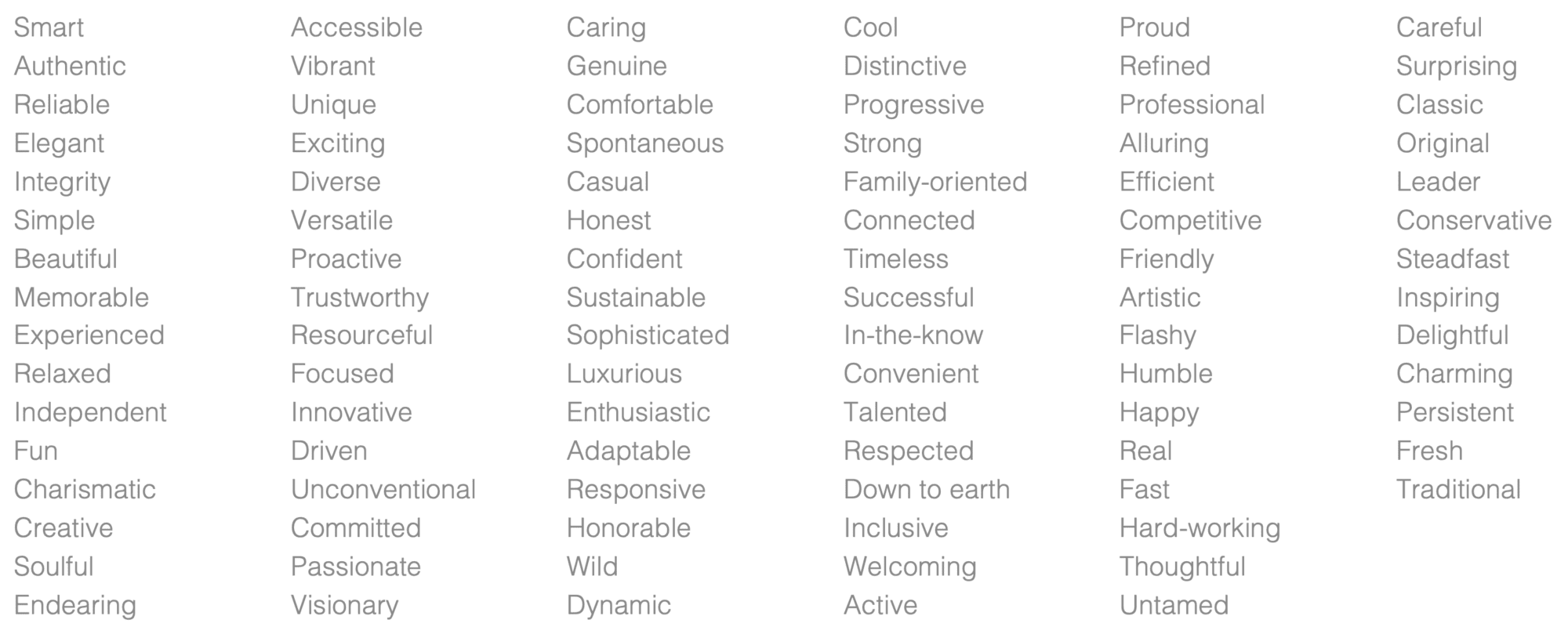
This is something you can do with your team right now. What you may find, as we often do, is an almost unbelievable amount of consistency among team members.
It can be hard to get a group of people to agree on anything, let alone the character of their brand. But for some reason, even within brands still under construction, patterns emerge. There seems to be an unspoken alignment in who a brand is set out to become.
We think this speaks to an underlying brand DNA – inherited from the founders, from strategy, from culture, habit. Whatever it precisely is, we give it the attention it deserves. And so should you.
So try it out for yourself. You might be surprised.
Expressing your brand to the outside world.
Another team exercise we do often yields similar overlap (or the opposite). While somewhat tongue-in-cheek, the implications in the answers to these questions – as well as how they’re answered – are suggestive.
- If your company were a famous person, who would it be? Who possesses the values, drive and passion you’ve been describing?
- If your company were a retail store, what store would it be? What kind of retail experience represents your ideal brand experience?
- What about a car brand? Are you the Jeep, Ford, Mercedes, Tesla of real estate branding?
These questions often allow our clients to take a step back and think of their brand outside of the confines of the homebuilding industry. By considering the position they aim for their brand to hold on a larger scope, they’re able to identify desired traits and qualities that can lead to a truly compelling brand.
Step 7: Your Customers – Who are you here for?
You’re not only learning who you are as a brand, but who are you for?
With a strong understanding of your brand identity, you can begin to cultivate a reputation that intuitively resonates with a specific audience. This is where we map out our key audiences and customers. You’ve likely heard one of the many terms before: target market, target audience, personas, ideal customer profile.
Whatever you call it, you need to build a representation of a few types of people you plan on winning over. There are several ways you can break down these audiences into categories based on different factors:
- Product Line – Perhaps your homes span across a wide price range and you know certain people will favor certain spots on that range.
- Common Needs/Lifestyles – This may be made up of buyers who will all be purchasing a single product line at a similar price.
- Buyer Status – Maybe your homes within different master-planned communities cater to buyers at different stages whether they are first-time buyers, move-up buyers, move-down buyers.
But however the breakdown, you should explore both demographics – age, gender, income, location – and psychographics – what they think, how they feel, how they behave, what they do.
With these artifacts, typically called personas, you’ll have a stronger idea of who you’re engaging with and what they want. You’ll know how to address them, solve their problems and delight them.
Simply, you’ll have empathy. A way to intuitively perceive and understand the needs and desires of your target audience. And what could be a better tool?
Step 8: Your Core Emotional Benefit – What do customers value most about you?
Behind every feature is an emotional benefit that provides a powerful offer for your buyers. As we’ve said before, homebuyers don’t identify with a 1,000 square foot backyard – they identify with summer nights playing catch with their kids. And open kitchen-to-living space doesn’t emotionally resonate. However, hosting the year’s best party does.
Which, in this case, is really to say: these homebuyers benefit by getting to be a great parent or a remarkable entertainer – advantages they should be able to easily imagine through strong branding.
Just as with many other elements of developing a strong brand, it’s important to take an insightful look over your offerings and uncover the valuable hidden meaning. As many sayings tell us, homes aren’t just a place to live, they’re where cherished memories are created.
The Brand Pyramid for Real Estate Branding
To assist in understanding the emotional value of both features and benefits, we like to use a tool called the Brand Pyramid.
Generally, the Brand Pyramid is known to connect product and brand attributes to the personal and social factors of a customer’s lifestyle. The traditional Brand Pyramid includes three categories: attributes or features, functional benefits and emotional benefits.
However, in 2011, the Boston Consulting Group proposed the addition of a fourth dimension to the model. This fourth dimension was social benefits.
Altogether, the four dimensions of the Brand Pyramid are:
- Attributes – Physical features of the products.
- Functional benefits – What is the unique selling proposition of the product and why it is functionally different from the market?
- Emotional benefits – What sense of security, purpose, and other positive emotional qualities does the brand deliver customers?
- Social benefits – How does the brand increase the stature of the customer in the eyes of his or her social circle? In other words, how does the brand affect status?
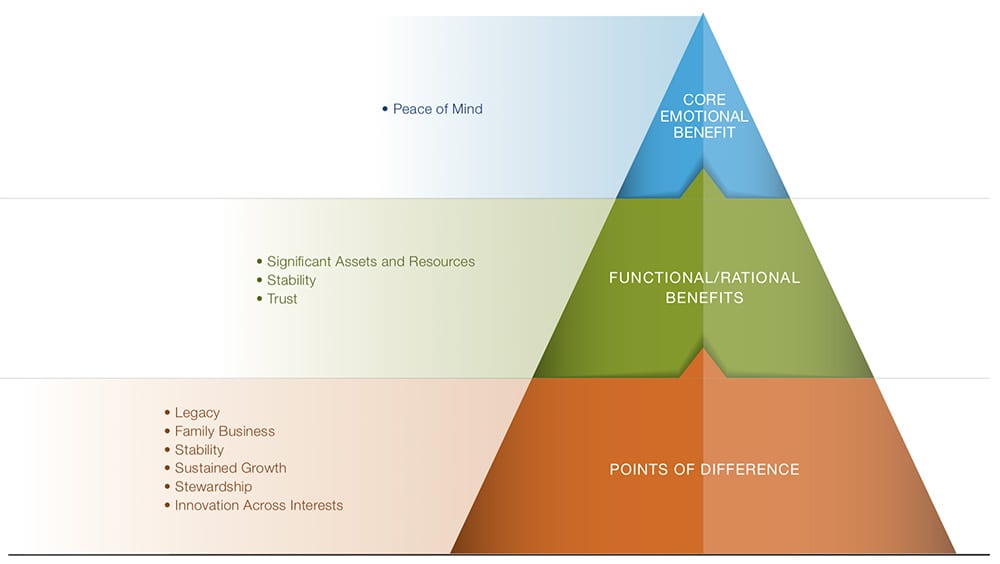
As you move from your features to your unique benefits and eventually to your emotional benefits, it should become increasingly clear which among them is your core emotional benefit.
This core benefit is the answer to the question: What do your customers value most about you? And why, at the heart of it all, are people buying from your brand?
Step 9: Your Brand Positioning Statement – What is your elevator speech?
The brand positioning statement describes the “mental space” we want the brand to occupy in the minds of the target audience.
It serves as an internal roadmap to help guide marketing strategies, programs and tactics across all communication platforms by digging into the deeper value provided to your key audience. The brand positioning statement focuses on the elements and associations that meaningfully set your brand (home builder or community) apart from the competition.
Brand Positioning Statement Structure:
Here is a framework you can use to get started:
To the [target audience], [your brand] offers [core emotional benefit].
Let’s look at an example of a positioning we did for Mediterra, a South Florida-based luxury master-planned community.
First, we identified the target audience:
“Affluent, active adults with an average net worth of $10 million, interested in a second home in Naples, Florida.”
Then, we briefly describe the brand and explore our features and benefits, searching for the core emotional benefit.
“Mediterra, 9-time winner of Best Community In Naples, offers a unique combination of two Tom Fazio-designed golf courses and a private beach club.”
Now, those are excellent features, but we need to find the buyer motivation. What is the ultimate reason buyers will feel drawn to this luxury community? At a deeper level, we realize the core emotional benefit is this: Living at Mediterra validates the buyer’s self-identity and inherent need for gains in social status.
Finally, we build the positioning statement.
“To affluent, active adults with an average net worth of $10 million, Mediterra, the 9-time winner of Best Community in Naples, offers luxury homes that validate the buyers’ self-identity and inherent need for gains in social status.”
A quick note here. As we said above, the positioning statement is an internally-facing artifact. So, if you were rightfully concerned about telling buyers you will quench their thirst for status, you don’t need to worry. This language is only for you, your team, investors, partners and colleagues. Forming the positioning statement is about further enhancing your understanding of the target audience and utilizing that knowledge to effectively shape brand communication.
Step 10: Your Brand Promise – What is your tagline?
A strong brand promise is crucial to answering the most important value creation question of all: “Will people perceive a difference that is desirable?”
An effective brand promise answers that question by providing a blueprint for differentiating the enterprise and, in doing so, delivers a sustainable competitive advantage.
The brand promise reduces the essence of the brand into a short, strategic phrase with two important purposes:
- First, the brand promise provides internal clarity. It gives members of the organization a succinct and memorable way to introduce, explain and discuss the brand by always using the same words to begin conversations about the brand. A strong brand promise acts as an internal mantra that drives and strengthens brand identity.
- Second, the brand promise positions the brand in the minds of the target audience. By reinforcing mental associations, it helps customers remember the brand and informs them on what they can expect from the brand. Ideally, this promise should be a message that is reinforced across all of the brand’s touch points.
Well known examples include:
- Nike – “Just do it”
- Target – “Expect More. Pay Less.”
- Apple – “Think Different.”
Coming up with a captivating brand promise is hard work. It can be helpful to look at a few categories in which most brand promises belong:
Imperative – Commands action and usually starts with a verb.
- Nike – “Just do it”
- MINI Cooper – “Let’s motor”
- Apple – “Think Different”
Descriptive – Describes the service, product, or brand promise.
- TOMS Shoes – One for One
- TED – Ideas worth spreading
- Target – Expect more. Pay less.
Superlative – Positions the company as best in class.
- DeBeers – A diamond is forever
- BMW – The ultimate driving machine
- Budweiser – King of beers
Provocative – Thought-provoking. Often a question.
- Dairy Council – Got milk?
- Mercedes-Benz – What makes a symbol endure?
- Microsoft – Where are you going today?
Specific – Reveals the business category.
- HSBC – The worlds local bank
- The NY Times – All the news that’s fit to print
- Olay – Love the skin you’re in
Bonus Step: Choose an Agency with Exceptional Branding Expertise for Success
Real estate brand differentiation is critical for achieving successful sales and strong buyer connections – and no one knows that better than the Milesbrand team! We are highly skilled at identifying a brand’s most significant differentiator – their Brand DNA – through a well-defined, proprietary branding process.
With decades of unmatched expertise, our team then works to bring your brand to life and introduce it to the right target audiences. Ready to connect with Milesbrand for all of your real estate or home builder marketing needs? Contact us today.

